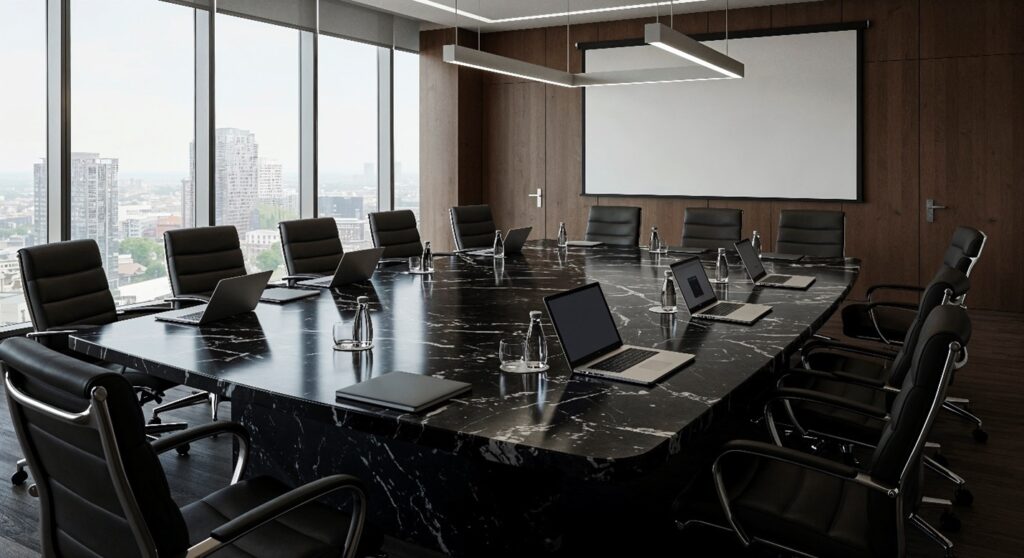Avoid These 5 Pitfalls in Conference Room Design

A conference room is often where critical decisions are made, relationships are strengthened, and new ideas take shape. When thoughtfully designed, it fosters clarity, collaboration, and focus. Yet, when certain elements are overlooked, it can limit productivity and leave a poor impression on clients and staff alike.
At Direct Office Furniture, we specialize in creating impactful spaces through customized office furniture that uplifts business environments across Bethesda, MD, and Laurel, MD. To help you build a conference room that truly supports your team’s success, here are five key pitfalls to avoid—and the thoughtful solutions that set high-performing spaces apart.
Inadequate Alignment Between Table Size and Room Dimensions
Selecting the right conference table size relative to your conference room size is fundamental. A table that dominates the room leaves little space for movement, while an undersized table can feel disproportionate and diminish the room’s presence.
Strategic Considerations:
- Maintain a minimum clearance of 36–48 inches around the table perimeter to allow for comfortable movement.
- Align table capacity with typical and maximum expected attendance.
- Choose table shapes—rectangular, oval, or modular—that support both communication flow and spatial efficiency.
Proper sizing establishes balance, optimizes comfort, and conveys a sense of thoughtful professionalism from the moment participants enter the room.
Poor Acoustic Planning
Visual aesthetics alone cannot deliver an effective meeting experience. Sound quality plays an equally critical role. A room dominated by hard surfaces—glass walls, stone floors, large wooden tables—may cause sound to echo, impairing speech clarity.
Practical Solutions:
- Introduce acoustic wall panels, padded seating, and area rugs to absorb excess noise.
- Install soft-close doors and consider sound-masking systems to reduce external disruptions.
- Choose quality office furniture that supports acoustic performance without compromising design integrity.
Incorporating acoustic strategies creates an environment where communication is effortless, helping meetings proceed with clarity and confidence.
Technology Integration Treated as an Afterthought
In the modern workplace, unified technology integration is not optional but essential. Conference rooms must support a range of digital interactions without requiring complicated setup or visible cable clutter.
Recommendations:
- Specify tables with integrated power and data ports, tactically positioned to remain accessible but discreet.
- Include wireless presentation systems and high-resolution display screens in the design phase, not post-installation.
- Dedicate space for AV equipment, routers, and other peripherals within credenzas or integrated cabinetry.
When technology is planned carefully alongside furniture and layout, meetings begin smoothly, and attention remains focused on objectives, not on troubleshooting.
Neglecting Comfort and Ergonomics
Conference rooms should facilitate extended periods of engagement without discomfort. Prioritizing comfort is not a luxury—it directly influences concentration, participation, and decision-making quality.
Critical Factors:
- Select ergonomically designed chairs with adjustable features for lumbar support and proper posture.
- Implement layered lighting strategies combining ambient, task, and accent lighting to accommodate various meeting types.
- Maintain room temperature consistency, avoiding vents placed directly over seating areas.
Additionally, thoughtful inclusion of biophilic elements—such as natural light, plants, or organic textures—has been shown to reduce stress and boost cognitive function during prolonged discussions.
Overlooking the Impact of Color Psychology
Color selection is not merely an aesthetic decision; it profoundly affects mood, energy, and engagement within a space.
Intentional Color Choices:
- Blue tones promote calm, concentration, and trust—ideal for analytical or strategic sessions.
- Green hues foster a sense of balance and restoration, supporting longer, more intensive meetings.
- Neutral palettes create a grounded atmosphere, allowing focus to remain on content rather than surroundings.
- Subtle accents of yellow or orange can introduce a sense of dynamism and creative energy when appropriate.
Merging color psychology thoughtfully helps align the room’s atmosphere with the intended purpose of the meeting, subtly supporting better outcomes.
Additional Elements to Consider
- Flexible Layouts: Design spaces that adapt to different meeting styles, from formal presentations to informal brainstorming.
- Smart Storage: Integrate discreet storage for AV equipment, supplies, and additional seating to maintain an uncluttered aesthetic.
- Brand Identity: Subtly incorporate brand colors, logos, or values through curated artwork and design accents.
- Accessibility: Prioritize ADA compliance in pathways, table heights, and control interfaces to accommodate all users.
- Maintenance Planning: Choose surfaces and fabrics that are easy to maintain and durable against high-frequency use.
Make Every Meeting Count
A well-designed conference room doesn’t just look good—it works hard. It welcomes ideas, supports technology, promotes focus, and leaves clients impressed. And the best part? It becomes a space your team wants to use.
Explore customized office furniture designed to bring out the best in your space. From sleek tables to tech-friendly layouts and acoustically balanced environments, we help businesses in Bethesda, MD, and Laurel, MD, create meeting rooms that get results.
Explore our complete collection of office furniture here, and contact our expert team to create a workspace that drives productivity and professionalism.
Direct Office Furniture’s Conference Management Solutions
Don’t just redesign a room—redefine the way your team connects.
